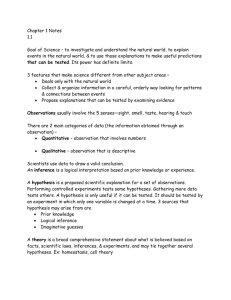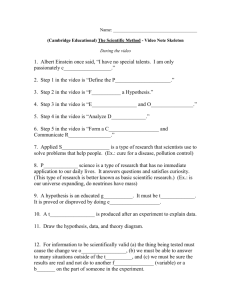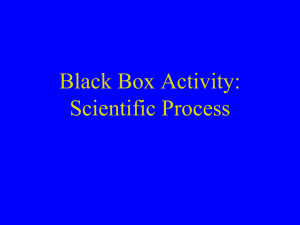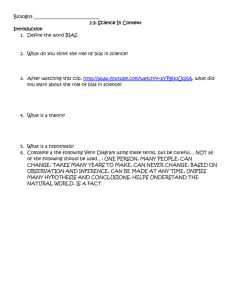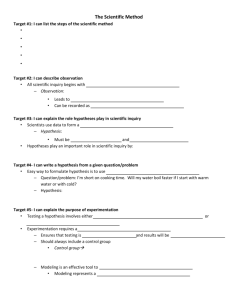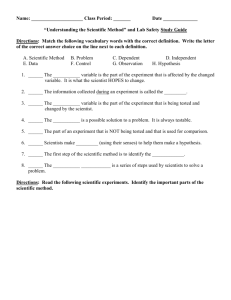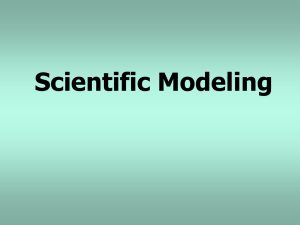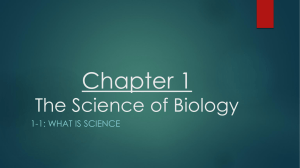The Science of Biology
advertisement
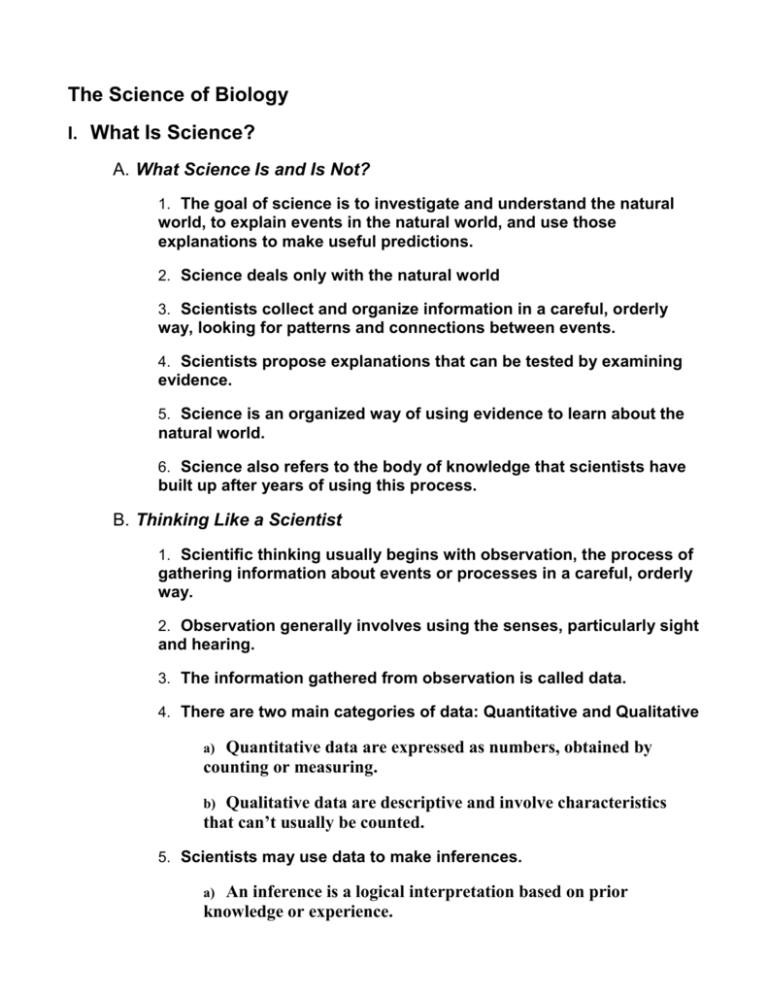
The Science of Biology I. What Is Science? A. What Science Is and Is Not? 1. The goal of science is to investigate and understand the natural world, to explain events in the natural world, and use those explanations to make useful predictions. 2. Science deals only with the natural world 3. Scientists collect and organize information in a careful, orderly way, looking for patterns and connections between events. 4. Scientists propose explanations that can be tested by examining evidence. 5. Science is an organized way of using evidence to learn about the natural world. 6. Science also refers to the body of knowledge that scientists have built up after years of using this process. B. Thinking Like a Scientist 1. Scientific thinking usually begins with observation, the process of gathering information about events or processes in a careful, orderly way. 2. Observation generally involves using the senses, particularly sight and hearing. 3. The information gathered from observation is called data. 4. There are two main categories of data: Quantitative and Qualitative Quantitative data are expressed as numbers, obtained by counting or measuring. a) Qualitative data are descriptive and involve characteristics that can’t usually be counted. b) 5. Scientists may use data to make inferences. An inference is a logical interpretation based on prior knowledge or experience. a) C. Explaining and Interpreting Evidence 1. Scientists try to explain events in the natural world by interpreting evidence logically and analytically. 2. After initial observations, the researchers will propose one or more hypotheses. A hypothesis is a proposed scientific explanation for a set of observations. a) Scientists generate hypotheses using prior knowledge, or what they already know; logical inference; and informed, creative imagination. b) Scientific hypotheses must be proposed in a way that enables them to be tested. c) D. Science as a Way of Knowing E. Science and Humans II. How Scientists Work A. Designing an Experiment 1. Ask a Question For many years, observations seemed to indicate that some living things could just suddenly appear. a) b) How do new living things, or organisms, come into being? 2. Forming a Hypothesis For centuries people accepted that life somehow “arose” from nonliving matter which they called spontaneous generation. a) b) Write an If/Then statement. 3. Setting Up a Controlled Experiment In science, testing a hypothesis often involves designing an experiment. a) Whenever possible, a hypothesis should be tested by an experiment in which only one variable is changed at a time. b) (1) Control group (control): used as a standard for comparison (a) All conditions are kept the same during the experiment. (b) All controlled experiments must have a control(s). (2) Experimental group (unknown): the test group (a) All conditions are kept the same except for the single condition being tested. (b) Test only one condition at a time. Independent variable: the condition in an experiment that is changed (3) (a) The only variable that affects the outcome of the experiment. (b) The experimenter is in charge of all aspects of the independent variable. Dependent variable: a second condition that is observed and/or measured resulting from the change (4) (a) Any changes in this variable depend on the change made to the independent variable. (b) Events/conditions observed or measurements taken constitute the dependent variable 4. Recording and Analyzing Results Observation and/or measurements that are made need to be recorded when completed. a) 5. Drawing a Conclusion a) Accept or reject the hypothesis B. When Experiments Are Not Possible 1. It is not always possible to do an experiment to test a hypothesis. a) How animals in the wild interact with others in their group. b) Ethical considerations prevent contain experiments. C. How a Theory Develops 1. As evidence form numerous investigations builds up, a particular hypothesis may become so well supported that scientists consider it a theory. 2. In science, the word theory applies to a well-tested explanation that unifies a broad range of observations. 3. A useful theory may become the dominant view among the majority of scientists, but no theory is considered absolute truth. III. Studying Life A. The word biology means the study of life. (The Greek word bios means “life,” and –logy means “study of.” B. Biology is the science that seeks to understand the living world. C. Characteristics of Living Things 1. Living things share the following characteristics: a) Living things are made up of units called cells. A cell is a collection of living matter enclosed by a barrier that separates the cell from its surroundings. (1) b) Living things reproduce. (1) Sexual reproduction (2) Asexual reproduction c) Living things are based on a universal genetic code. d) Living things grow and develop. Growth results in an increase in the amount of living material which is known as biomass. (1) Development is a result of the changes that take place during the life of an organism. (2) e) Living things obtain and use materials and energy. The combination of chemical reactions through which an organism builds up or breaks down materials as is carries out its life processes is called metabolism. (1) f) Living things respond to their environment. (1) A stimulus is a signal to which an organism responds. g) Living things maintain a stable internal environment. (1) h) Homeostasis Living things (as a group) change over time. (1) Process of evolution D. Branches of Biology 1. No single biologist can study all the diversity that life consists of, so biology is divided into different fields. 2. Some levels at which life can be studied include molecules, cells, organism, populations of a single kind of organism, communities of different organisms in an area, and the biosphere. 3. At all these levels, smaller living systems are found within larger systems. IV. Tools and Procedures A. A Common Measurement System 1. Scientists use the metric system (SI) when collecting data and performing experiments. 2. The metric system is a decimal system of measurement whose units are scaled on multiples of 10. a) meter (length/distance) b) liter (volume) c) gram (mass) d) Celsius or Kelvin (temperature) (1) 0ºC = freezing point of water (2) 100ºC = Boiling point of water (3) 37ºC = normal human body temperature (4) 22ºC = room temperature (5) 0 K = absolute zero (6) 0 K = -273º C B. Microscopes 1. Microscopes are devices that produce magnified images of structures that are too small to see with the naked eye. 2. Compound light microscopes produce magnified images by focusing visible light rays.

